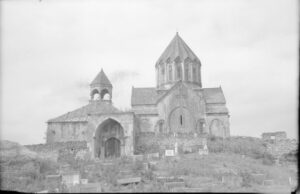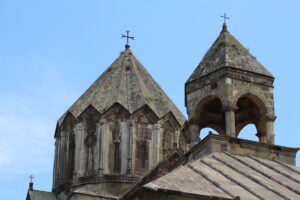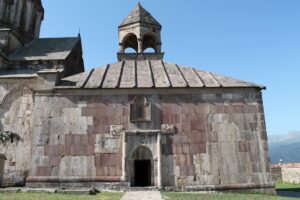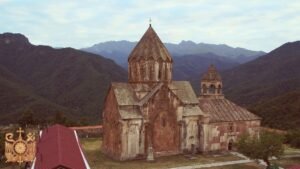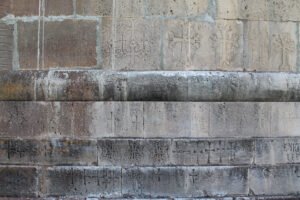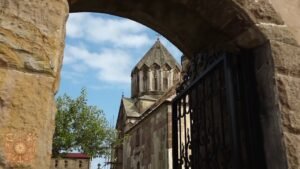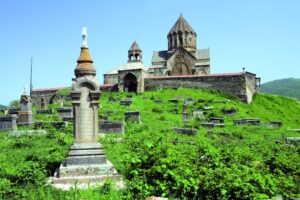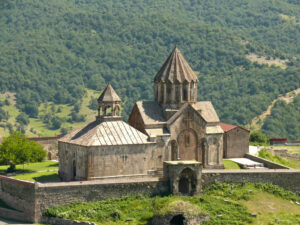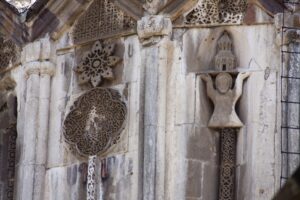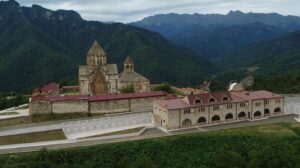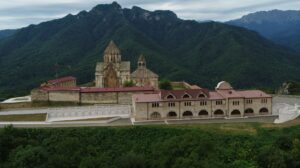Gandzasar
Martakert Province, village Vank
Գանձասարը հայ միջնադարյան ճարտարապետության գլուխգործոցներից է, որը գտնվում է Լեռնային Ղարաբաղի Մարտակերտի շրջանի Վանք գյուղից հյուսիս-արևմուտք՝ անտառապատ լեռան գագաթին: Հուշարձանախումբը բավական շահեկան դիրք ունի: Վանքը գտնվում է Խաչենի գեղատեսիլ ձորի վրա և նկատելի է հեռվից իր բարձր դիրքի և կարմրավուն տուֆից կառուցված շինությունների շնորհիվ:
Գանձասարի առաջին գրավոր հիշատակությունը պատկանում է 949 թվականին: 12-րդ դարում այն արդեն հայտնի էր որպես Խաչենի իշխանների տոհմական տապանատուն: 1216-1238 թվականներին Արցախ-Խաչենի իշխանաց-իշխան Հասան-Ջալալ Դոլան կառուցում է վանքի Սուրբ Հովհաննես Մկրտիչ եկեղեցին, իսկ 1261 թվականին՝ գավիթը:
15-րդ դարում Գանձասարը դառնում է Աղվանքի կաթողիկոսության կենտրոնը: 17-րդ դարում նորոգվում են տաճարն ու գավիթը, վանքը շրջապատվում է պարիսպներով: 18-րդ դարում Գանձասարը վերածվում է Ղարաբաղի մելիքությունների քաղաքական և ռազմական կենտրոնի: 1712 թվականին Եսայի կաթողիկոսի հավաքած զորքը և վրացական բանակը միասին պարտության են մատնում Անդրկովկաս ներխուժած Դաղստանի լեռնականներին: 1725 թվականին նրա ոգեշնչմամբ և կազմակերպչական ջանքերով Ղարաբաղի մելիքությունների միացյալ զորքը ջախջախեց Վարանդա ներխուժած թուրքական զավթիչներին: 1762 թվին այստեղ կայանում է Հովհաննես կաթողիկոսի և հայ ազատագրական շարժման ղեկավար Հովսեփ Էմինի հանդիպումը:
Գանձասարի համալիրը բաղկացած է եկեղեցուց, գավթից, բնակելի խցերից, տնտեսական շինություններից և 19-րդ դարում կառուցված դպրոցի երկհարկանի շենքից: Ամբողջ համալիրը շրջապատված է պարիսպներով:
Գանձասարի եկեղեցին առանձնանում է իր հարուստ հարդարանքով և քանդակների առատությամբ: Գմբեթի քանդակները ոչ միայն ճարտարապետական հարդարանքի բացառիկ օրինակ են, այլև ունեն իմաստավորված բովանդակություն: Գմբեթի արևմտյան նիստերի վրա պատկերված են երկու ծալապատիկ նստած մարդիկ, որոնք գլուխներից վերև պահում են երկու եկեղեցիների մանրակերտներ՝ Գանձասարը և չպահպանված Վաճառը:
Եկեղեցու արևմտյան ճակատին կա Խաչելության տեսարանի բարձրարվեստ պատկերաքանդակը: Շինության վրա կան բազմաթիվ այլ քանդակներ՝ եզան գլուխ, թևատարած արծիվ, թռչուններ և այլն:
Համալիրից հարավ ընկած է հին գերեզմանատունը, որտեղ թաղված են Խաչենի հոգևոր և աշխարհիկ նշանավոր գործիչներ, ուշ միջնադարում՝ մելիքները:
Իր բացառիկ ճարտարապետությամբ Գանձասարը իրավամբ համարվում է «13-րդ դարի հայ ճարտարապետության հանրագիտարանը»:
Աղբյուր՝ Մուրադ Հասրաթյան «Հայկական ճարտարապետության Արցախի դպրոցը»


